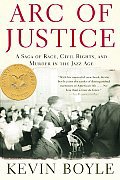
The arc of the moral universe is long,
But it bends toward justice.
-Abolitionist Theodore Parker, c. 1850's
That Justice is a blind goddess
Is a thing to which we blacks are wise.
Her bandage hides two festering sores
That once perhaps were eyes.
-Langston Hughes, 1923
(from the frontspiece of Arc of Justice).
Arc of Justice: A Saga of Race, Civil Rights, and Murder in the Jazz Age, by Kevin Boyle is an incredible book. It is very obviously meticulously well-researched (there are masses of endnotes on newspaper articles, court transcripts, insurance & real estate info., etc) - the author is a professor of history at Ohio State, but grew up in Detroit and got his PhD at the University of Michigan.
Boyle narrates the story of Ossian Sweet, an African-American doctor who bought a house for his wife & 14 month old daughter in a white neighborhood in Detroit in 1925. When a violent mob of hundreds of people surrounded the house the second night after they moved in, one of the 11 people trapped in the house shot a gun out of an upstairs window and one man on the street was killed and another was wounded.
Boyle starts out with a riveting account of the night this happened, then moves back to provide Sweet's family history and a good history of Reconstruction and Jim Crow in the south, and then the Great Migration to the industrial northern cities in the years following WW I.
He makes it easy to imagine living in Detroit in the 1920's, either as an immigrant workman in the Ford plants, or as a doctor or housewife in the black ghetto in Detroit (the "Black Bottom" or Paradise Valley). He shows how ghettos and residential segregation developed from the economic and social changes of the 20's, and how the all-pervasive racism of the day fueled this.
Some of the mechanics of the history are a bit dry, but Boyle manages to bring the economy, sociology, and history back to actual people and how they dealt with these changes and events, and that really keeps you reading.
A lot of the history is shocking and not something that you probably read about in high school (or even college) when you learned about this era: lynchings and race riots. I never knew about the early 20th century riots in Chicago, Springfield, IL, Tulsa, East St. Louis, or Rosewood, FL until a few years ago. This book makes you realize that the north has nothing to be sanctimonious about just because there weren't as many lynchings here.
The last third or so of the book deals with the murder trial (all eleven people in the house were co-defendants, and included two of Ossian's brothers and his wife Gladys). The NAACP made it into a national event, and got Clarence Darrow (who had just finished the Scopes trial earlier in the year) to be one of the defending attornies.
I learned a huge amount about Detroit politics, the KKK, immigration and real estate practices. Boyle finishes up with a look at how segregation developed in Detroit (and elsewhere in the US) after the trial, and what happened to everyone involved after the trial. Not coincidentally, Detroit is still the most segrated major city in the US*.
There is a major shock at the very end, which I'm not going to spoil, so whatever you do don't read the ending of the book before reading the rest.
HNN has an interesting interview with Boyle, where he talks about why he chose Ossian Sweet's story, his research, and some of the other titles he considered. You can take a look at the Sweet house on the National Park Service's Register of Historic Places (where a marker was just put up in 2004), or here at a wonderfully detailed site provided by the Population Studies Center of the Institute for Social Research at University of Michigan. Just don't read the accompanying text unless you want spoilers for the book, or you know that you're not going to read the book.
There are pictures of all the major characters and more information on the trial here, and an interesting article in American History magazine was written in 2000 by John F. Wukovits.
*CensusScope says the Gary, IN metro area is slightly worse, but note how many other Michigan cities are in the top 25.
3 comments:
Martin Luther King, Jr. made the "arc of justice" quote famous: “We shall overcome because the arc of a moral universe is long, but it bends towards justice. We shall overcome because Carlyle is right - no lie can live forever. We shall overcome because William Cullen Bryant is right - truth crushed to earth will rise again. We shall overcome because James Russel Lowell is right - 'truth forever on the scaffold, wrong forever on the throne, yet that scaffold sways the future, and behind the demon known, stands a God within the shadow, keeping watch above his own.” From "Remaining Awake Through a Great Revolution", 31 March 1968
Note also that this was the 2004 National Book Award winner for non-fiction: http://www.nationalbook.org/nbawinners2000.html
Readers might also be interested in Kevin Boyle & Victoria Getis's book of historic photographs of Detroit: Muddy Boots and Ragged Aprons: Images of Working Class Detroit 1900-1930.
Post a Comment